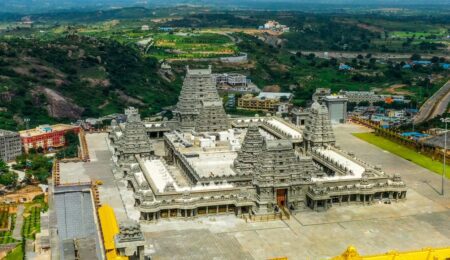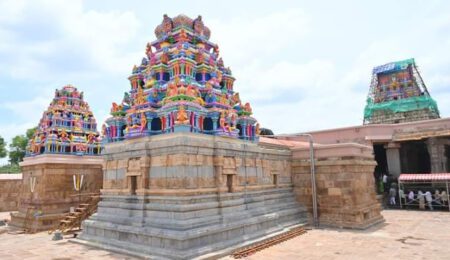Kandariya Mahadeva Temple: The Grandeur of Khajuraho’s Architectural Marvel
Introduction
The Kandariya Mahadeva Temple stands as a breathtaking testament to medieval Indian architecture, religious fervor, and the zenith of artistic achievement. Located in Khajuraho, Madhya Pradesh, this grand edifice is not just the largest and most ornate Hindu temple in the Khajuraho Group of Monuments, but a symbol of the Chandela dynasty’s cultural and architectural legacy. Constructed between 1025–1050 CE, it continues to draw scholars, art lovers, spiritual seekers, and tourists from around the world.
Historical Background
The Chandela Dynasty and Khajuraho’s Golden Era
The Chandela rulers, governing central India between 950 and 1050 CE, created a remarkable cluster of Hindu and Jain temples in Khajuraho a period regarded as the golden age of temple architecture in the region.
King Vidyadhara’s Triumph and Temple’s Construction
Commissioned by King Vidyadhara (r. circa 1003–1035 CE), known as “Virimda” in inscriptions, the Kandariya Mahadeva Temple was constructed following his military victories, including engagements with Mahmud of Ghazni. The epigraphic evidence on a mandapa pillar links the monument firmly to the Chandela king’s reign.
UNESCO World Heritage Recognition
Selected for the UNESCO World Heritage List in 1986, Khajuraho especially the Kandariya Mahadeva Temple was recognized for its artistic creativity (Criterion III) and its illustration of Chandela cultural traditions (Criterion V).
Architectural Significance
Nagara Style: Temple as Cosmic Mountain
Crafted in Nagara (North Indian) style, the temple’s architecture embodies the concept of Mount Meru a sacred cosmic mountain. Its soaring form and profuse ornamentation align with broader Hindu cosmology.
Jagati and Ritual Landscapes
Built upon a jagati (a raised platform or plinth), the temple elevates its sanctum, facilitating ritual circumambulation (pradakshina) and enhancing its spiritual dimensions.
Shikhara with 84 Urushringas
The temple’s central spire (shikhara) is encircled by 84 urushringas miniature subsidiary spires that accentuate verticality and reinforce the mountain-like form of the temple’s silhouette.
Spatial Mastery and Visual Flow
Architectural analysis reveals a masterful plan that combines expansion and contraction elements like mahamandapa, mandapa, and ardhamandapa interlock to create dynamic visual flow and layered spatial experiences.
Meticulous Stone Craftsmanship
Rendered in fine sandstone, each sculpted panel, floral motif, and deity image exhibits precision carving. The structure uses mortise-and-tenon joinery for stone assembly a testament to the engineering skills of the era.
Sculptures & Symbolism
A Profusion of Masterpieces
Khajuraho’s temples strike a delicate balance between architecture and sculpture. The Kandariya Mahadeva Temple is adorned with over 800 exquisitely rendered figures, representing divine beings, mythical creatures, and spiritual narratives.
Erotic Imagery in Context
Erotic imagery, while famous, occupies less than 10% of the sculptural content. These panels delicate and balanced reflect the holistic Hindu understanding of life’s dimensions, including kama, artha, dharma, and moksha.
Divine Residents and Spiritual Themes
Interspersed among erotic depictions are divine figures such as Shiva in various forms, apsaras (celestial nymphs), dikpalas (directional guardians), and animal motifs. Each panel contributes to a rich tapestry of spiritual storytelling.
Religious & Cultural Importance
Shaivite Centerpiece
Dedicated to Lord Shiva, the temple houses a marble Shivlinga in the sanctum sanctorum. It continues to serve as an active site of worship, particularly during Maha Shivaratri and other ritual occasions.
Living Heritage
Beyond being an archaeological monument, the temple remains a vibrant center of spiritual engagement linking past traditions with contemporary devotion.
You are reading about Kandariya Mahadeva Temple
Conservation & Preservation
ASI’s Restoration Efforts
The Archaeological Survey of India (ASI) has undertaken ongoing restoration and cleaning efforts to preserve structural integrity and intricate carvings. These interventions ensure that the temple remains intact for posterity.
Balancing Tourism and Preservation
With Khajuraho’s designation as an “iconic tourist destination,” concerns arise about increased infrastructure and vibration impacts on fragile sculptures. Conservationists urge careful management to avoid compromising the temples’ sanctity and structure.
ASI’s Vigilance on Modifications
Past controversies, such as repainting of nearby Jain temples, prompted ASI to reinforce guidelines and transparency regarding site modifications near these world heritage monuments.
Tourist Guide
Best Time to Visit
The temple is most appealing between October and March, when the weather in central India is cooler and photography conditions are ideal.
Visiting Details
Though entry fees vary commonly around ₹10 for Indian citizens and higher for foreign nationals please verify current charges before planning your visit . Local amenities include guided tours, photography, and festival-driven cultural programs like the Khajuraho Dance Festival in February .
Access & Nearby Attractions
Khajuraho is well-connected by rail and road; the nearest airport is Khajuraho Airport. The temple lies within the Western Group of temples, alongside other significant monuments such as the Lakshmana Temple, Vishwanatha Temple, and Parshvanatha Temple .
You are reading about Kandariya Mahadeva Temple
Lesser-Known Insights & Interesting Facts
- Architectural Symbolism: The temple layout and complex geometry align with mandala designs observed in cosmic symbolism—incorporating squares, triangles, and pentagonal layouts that mirror Hindu cosmology .
- Water Symbolism: Khajuraho’s temples were historically surrounded by numerous water bodies some scholars locate 56 out of an original 64 tying the sacred geography to purification rituals .
- Vivid History of Rediscovery: After centuries of neglect, British surveyor T S Burt helped reintroduce Khajuraho to the world in the 1830s. Since then, the site has become pivotal for heritage conservation .
- Spiritual Quadrants: Some scholars interpret the Western Group’s temple arrangement as a cosmic yantra, symbolizing aspects of Shiva’s forms and their harmony in spatial layout .
Why Kandariya Mahadeva Temple is a Must-Visit
- Architectural Pinnacle: A masterwork of Nagara-style architecture, with its towering shikhara and ornate carvings, this temple stands as India’s medieval architectural acme.
- Cultural Tapestry: It blends sacred symbolism, mythological storytelling, and sensual artistry presenting a vivid narrative of ancient Indian ethos.
- Living Heritage: It isn’t merely a relic; it remains a place of worship, a cultural stage, and a reservoir of tradition.
- Heritage & Global Appeal: As part of a UNESCO World Heritage Site, it holds universal value. Its unique artistry and spiritual depth make it unforgettable.
FAQ
Q: Who built the Kandariya Mahadeva Temple?
A: Commissioned by Chandela king Vidyadhara (Virimda), constructed between 1025–1050 CE as a tribute to Shiva and celebration of military success.
Q: What makes Khajuraho’s erotic sculptures unique?
A: Though widely recognized, erotic imagery constitutes less than 10% of the temple’s artwork and is harmoniously integrated with spiritual and mythic themes.
Q: How many sculptures are on Kandariya Mahadeva Temple?
A: It features over 800 finely carved sculptures, depicting gods, celestial beings, mythic narratives, and daily life scenes .
Q: How is the temple being preserved?
A: The Archaeological Survey of India (ASI) oversees restoration, cleaning, and structural reinforcement. Collaboration with cultural bodies ensures ongoing conservation.
Q: When is the temple open and what are the entry fees?
A: Generally open daily; timings and entry fees (commonly ₹10 for locals, higher for foreigners) are subject to change always verify beforehand .
Conclusion
The Kandariya Mahadeva Temple is more than a temple it is a monument of devotion, a canvas of divine stories, and a sculptural miracle. From its soaring shikhara adorned with 84 urushringas to its intricate balance of sensuality and spirituality, it stands tall as a cultural and architectural benchmark. Through vigilant preservation and mindful tourism, we can ensure its splendor endures and continues to inspire global admiration.




Leave a Comment